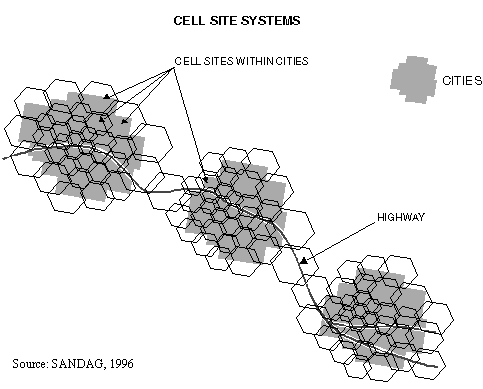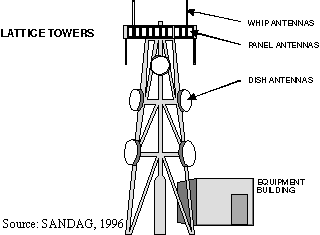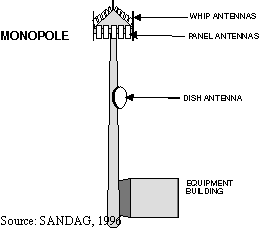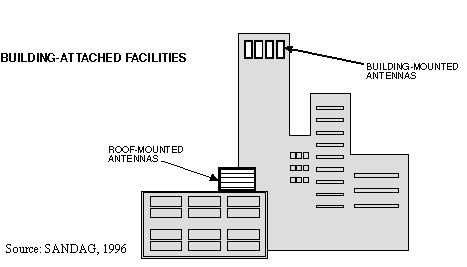 |
Meeting The Challenges of Zoning in the Information Age: Planning For Wireless Communications Facilities |  |
 |
Meeting The Challenges of Zoning in the Information Age: Planning For Wireless Communications Facilities |  |
There are two main categories which best describe the literature reviewed for this project. They are wireless communications technology and ordinances dealing with wireless facilities. This chapter is devoted to an analysis of the literature falling into these categories.
One of the most important aspects of this project is the nature of the technology behind wireless communications. In order to design a technically competent set of regulations, examination of wireless technology is vital. This section on technology will cover the principles behind the three main types of wireless communication (Cellular, Enhanced Specialized Mobile Radio, and Personal Communications Services) and the types of towers and antennas used in the physical infrastructure of the wireless environment.
Before examining the three types of wireless communications, it is important to understand the basics of wireless
transmissions. Wireless communications are transmitted through the air via radio waves of various frequencies. Radiofrequency
radiation (RFR) is one of several types of electromagnetic radiation. As illustrated in the diagram, cellular and ESMR
operate at frequencies between 800 and 900 MHZ, and PCS operates at both 900 MHZ as well as between 1,850 and 2,200 MHZ.

All three technologies described in this chapter function similarly in that their systems can be compared to the honeycomb pattern of a bee hive. Like the honeycomb pattern, these wireless communications systems are composed of interconnecting "cell sites," or geographical areas, that blanket a region. In this sense, all three technologies are "cellular technologies," although mobile cellular phones are frequently referred to as "the" cellular technology because they pioneered the concept (SANDAG, 1996).
The diagram here shows the relationship of cell sites within and between urbanized areas. As illustrated, cell sites tend to be smaller and more numerous in the central parts of cities, and larger and less abundant
in peripheral areas. This is because more people, and accordingly more customers, live in urbanized areas. As more people
begin to demand wireless communications services, wireless systems will require additional capacity to handle calls. This
additional calling capacity can be acquired in one of various ways: providers can increase the number of their cell sites,
use digital versus analog technology (explained in more detail below), or combine these two methods (SANDAG, 1996). As more
services are demanded, and more providers are thrown into the mix (a result of the Telecommunications Act of 1996), a
combination of the two above ways of adding capacity takes place. As the number of cell sites increases, the area of each
site offered by a provider becomes smaller in order to avoid overlapping coverage. As a result, a pattern emerges in which
the more populated central segments of cities contain smaller and more numerous cell sites, while the less populated edges of
cities, as well as rural areas, have fewer, but larger cell sites.
As illustrated, cell sites tend to be smaller and more numerous in the central parts of cities, and larger and less abundant
in peripheral areas. This is because more people, and accordingly more customers, live in urbanized areas. As more people
begin to demand wireless communications services, wireless systems will require additional capacity to handle calls. This
additional calling capacity can be acquired in one of various ways: providers can increase the number of their cell sites,
use digital versus analog technology (explained in more detail below), or combine these two methods (SANDAG, 1996). As more
services are demanded, and more providers are thrown into the mix (a result of the Telecommunications Act of 1996), a
combination of the two above ways of adding capacity takes place. As the number of cell sites increases, the area of each
site offered by a provider becomes smaller in order to avoid overlapping coverage. As a result, a pattern emerges in which
the more populated central segments of cities contain smaller and more numerous cell sites, while the less populated edges of
cities, as well as rural areas, have fewer, but larger cell sites.
As described in the introduction of this project, each cell contains antennas for transmitting and receiving wireless
communications data. Wireless communications utilize three different kinds of antennas to transmit data (See diagram below),
 whip antennas, panel antennas, and dish antennas. Whip and panel antennas function as the
transmitters and receivers of the radio waves that carry the conversation on a mobile phone, or the data for pagers. Dish
antennas serve as the link between the central switching computer (this links into the wire-based telephone network for
conventional phones), and the whip or panel antennas.
whip antennas, panel antennas, and dish antennas. Whip and panel antennas function as the
transmitters and receivers of the radio waves that carry the conversation on a mobile phone, or the data for pagers. Dish
antennas serve as the link between the central switching computer (this links into the wire-based telephone network for
conventional phones), and the whip or panel antennas.
Whip antennas (also known as stick, omnidirectional, or pipe antennas), emit signals in a 360 degree horizontal plane and a compressed vertical plane. Shaped cylindrically, whip antennas have diameters between two and six inches and measure between one and eighteen feet in height (Sprint Spectrum, 1996).
Panel antennas (also known as sector antennas) have vertical and horizontal planes that aim signals in specific directions. Panel antennas generally measure four to five feet in height, six to twelve inches in width, and six to eight inches in depth (Sprint Spectrum, 1996).
Dish antennas (also known as microwave dishes) have a different function than whip and panel antennas. Instead of emitting radio waves that carry the call between a wireless phone and its intended receiver, dish antennas emit microwaves that provide the critical link between the central computer switching system and the appropriate transmitting or receiving antennas. Essentially, dish antennas send microwave signals that allow the central switch to transfer the call between the various antennas closest to the mobile user (SANDAG, 1996). Dish antennas generally measure four to six feet in diameter and one-and-a-half to three feet in depth (Sprint Spectrum, 1996).
Antenna structures are typically accompanied by equipment buildings or boxes. Cellular and ESMR equipment buildings are generally less than 500 square feet in diameter. PCS equipment facilities, often called base stations, are self-contained weather-proof cabinets about the size of a vending machine (SANDAG, 1996).
The three types of antennas described above function on a line of sight transmission. Antennas need to be placed at specific heights in relation to one another in order to transmit and receive signals. As a result, height is a determining factor in the design and siting of wireless communications facilities. Typically, there are three types of antenna support-structures used to place antennas at desired heights: lattice towers, monopoles, and building-attached facilities (SANDAG, 1996).
The first type of tower is the lattice tower.
 Ranging from 60 to 200 feet in height,
lattice towers generally accommodate a variety of users, including cellular, ESMR, PCS and paging companies, as well as
public safety communications providers. Illustrated here, these towers generally have three or four support steel "legs" and
hold a variety of antennas. They can be found in areas where great height is needed, where multiple microwave antennas are
required, or where the weather demands a structurally-sound design (SANDAG, 1996).
Ranging from 60 to 200 feet in height,
lattice towers generally accommodate a variety of users, including cellular, ESMR, PCS and paging companies, as well as
public safety communications providers. Illustrated here, these towers generally have three or four support steel "legs" and
hold a variety of antennas. They can be found in areas where great height is needed, where multiple microwave antennas are
required, or where the weather demands a structurally-sound design (SANDAG, 1996).
Lattice towers, however, carry an inherent tradeoff: although they can accommodate many users (and provide co-location opportunities), they often pose serious visual impacts. Equipment and antennas concentrated on one large structure tend to draw more attention than the dispersal of less visible but more numerous facilities, such as smaller monopoles or building-attached facilities (SANDAG, 1996).
All three wireless technologies use monopoles,
 although their heights and designs vary.
Monopoles consist of a single pole, approximately three feet in diameter at the base, narrowing to roughly 1.5 feet at the
top, and may support any combination of whip, panel, or dish antennas (SANDAG, 1996). Monopoles are used in all areas, but
especially in rural areas, near freeways, or in areas where buildings are not of sufficient height to meet line of sight
transmission requirements. Monopoles are used much more commonly than lattice towers by wireless providers (mostly because
they are less visually intrusive, and therefore, "friendlier to local permitting agencies).
although their heights and designs vary.
Monopoles consist of a single pole, approximately three feet in diameter at the base, narrowing to roughly 1.5 feet at the
top, and may support any combination of whip, panel, or dish antennas (SANDAG, 1996). Monopoles are used in all areas, but
especially in rural areas, near freeways, or in areas where buildings are not of sufficient height to meet line of sight
transmission requirements. Monopoles are used much more commonly than lattice towers by wireless providers (mostly because
they are less visually intrusive, and therefore, "friendlier to local permitting agencies).
Building-attached antennas are used, for cellular, ESMR, and PCS, in three general forms:
 (1) roof-mounted, in which antennas are placed on the roofs of buildings,
(2) building-mounted, in which antennas are mounted to the sides of buildings, or (3) on smaller towers located on the roof
of a building (facilities also can be mounted on other structures such as water tanks, billboards, church steeples, or other
creative locations.). Although the visibility of building-attached facilities varies, roof-mounted antennas are generally
hidden from view because they are located in the middle of the roof or in boxed structures resembling air conditioning units.
Likewise, building-mounted antennas are also unnoticeable if they are painted to match the color and texture of the building
(SANDAG, 1996). Because of these reasons, building mounted facilities are attractive to local governments.
(1) roof-mounted, in which antennas are placed on the roofs of buildings,
(2) building-mounted, in which antennas are mounted to the sides of buildings, or (3) on smaller towers located on the roof
of a building (facilities also can be mounted on other structures such as water tanks, billboards, church steeples, or other
creative locations.). Although the visibility of building-attached facilities varies, roof-mounted antennas are generally
hidden from view because they are located in the middle of the roof or in boxed structures resembling air conditioning units.
Likewise, building-mounted antennas are also unnoticeable if they are painted to match the color and texture of the building
(SANDAG, 1996). Because of these reasons, building mounted facilities are attractive to local governments.
The problem with building facilities is finding structures tall enough to function with the existing system. Although building-attached facilities are becoming common, they can be used only when buildings meet the height required for antennas to function within the surrounding system. Where buildings do not meet height requirements, providers tend to use monopoles.
Another way to protect the aesthetics of a community is to disguise towers. Known as "stealth" facilities, there are a
number of architectural treatments that can be employed to hide a potentially damaging visual feature. Towers are disguised
in many ways, as trees
 (as seen in the picture here), silos, church steeples, etc.
(as seen in the picture here), silos, church steeples, etc.
As stated at the beginning of this section, there are three main kinds of wireless communication technology, cellular, Enhanced Specialized Mobile Radio (ESMR), and Personal Communications Services (PCS). Cellular uses analog technology (but many providers are converting to digital), while ESMR and PCS use digital technology.
Today wireless communications is in a process of shifting from analog technology to digital technology. Traditionally, cellular phones have utilized analog transmission signals. In the analog technology, voice messages are electronically replicated and amplified as they are carried from the transmitting antenna to the receiving antenna. A problem with this technology is that the amplification procedure tends to pick up "noise," sometimes making the message difficult to hear (SANDAG, 1996).
In order to diminish this noise and to provide greater calling capacity per channel, the wireless communications industry
is moving towards the use digital transmission signals. In digital technology, voice messages are converted into digits
(zeroes and ones) that represent sound intensities at specific points in time. Because natural pauses in the conversation
are eliminated, more calling capacity becomes available from the same amount of spectrum, thus reducing the need for new
sites (SANDAG, 1996). The background noise that is generally heard in the analog system becomes inaudible in a digital
system. As illustrated in the diagram here,

the graphic difference between the two technologies is that analog signals are
transmitted as continuous waves while digital technology converts the analog signal to binary digits (SANDAG, 1996).
Although paging is not addressed as an individual technology in this project, it is included in this discussion because it serves over 40 million users across the United States. Paging antennae are typically placed at lower elevations and at greater densities than antennas of other wireless communications systems. Paging companies typically need forty to fifty transmitters (containing one omnidirectional antenna each) for each five to seven mile radius in order to provide service to its current and future customers.
Paging companies do not typically construct their own facilities. Instead, most rent space at existing communications facilities sometimes known as multi-user sites. Multi-user sites that are located on building tops are an ideal location for paging facilities because paging companies have a great need for low-elevation sites (SANDAG, 1996).
The largest similarity between the three forms of wireless communications discussed in this section is that they all function on a network of interconnecting cell sites. As these technologies evolve in response to increasing consumer demand for wireless communications services and an increase in the number of service providers cell sites will be developed with smaller geographic radii, have antennas with lower heights, and will have more antennas per square mile than in the past (SANDAG, 1996).
The challenge for local and regional governments is to develop strategies to deal with the issues brought up in this overview of wireless communications technology. This project intends to provide the backdrop for governments and regulatory agencies, with the development of the model regulations.